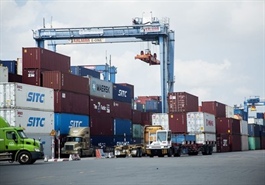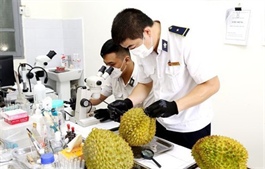Seafood export expected to reach $9 billion this year
Seafood export expected to reach $9 billion this year
Viet Nam will strive to achieve fisheries exports of US$9 billion this year, equivalent to the figure in 2019, the Viet Nam Association of Seafood Exporters and Producers, has said.

At the general meeting of the Viet Nam Association of Seafood Exporters and Producers in HCM City on June 12. — VNS Photo |
This comes after the industry experienced a record-breaking year in 2022, with exports reaching $11 billion for the first time in history.
At a general meeting of the association in HCM City on June 12, chairwoman Nguyen Thi Thu Sac spoke about the challenges facing the seafood industry in 2023.
The global inflation situation has worsened, resulting in a significant decrease in consumer demand and high inventory levels for businesses.
In the first five months of this year seafood exports amounted to just over $3.2 billion, a year-on-year decline of nearly 30 per cent.
Major markets such as the US, EU, and China saw decreases of 50 per cent, 32 per cent and 25 per cent.
Shrimp exports experienced a decline of nearly 36 per cent, pangasius nearly 40 per cent and tuna over 30 per cent during this period.
The ongoing conflict between Russia and Ukraine, coupled with high inflation and tight monetary policies, continue to impact the global economy.
Consequently, seafood demand in several markets will be hard to recover in the third quarter of 2023 as the forecast.
Apart from challenges posed by import markets, Vietnamese shrimp exporters face concerns over their competitiveness compared to shrimp from Ecuador and India due to higher production costs, and the European Commission's "yellow card" for Viet Nam's fishing activities.
The chairman of the association's shrimp committee, Do Ngoc Tai, attributed the 36 per cent drop in shrimp exports in the first five months to consumers tightening their spending and shifting to cheaper products due to high inflation.
He predicted that shrimp exports to major markets such as the US, EU, Japan, China, and South Korea would increase from August to cater to the festive season at the end of the year.
Le Van Quang, the association's chairman and general director of Minh Phu Seafood Corporation, noted that Viet Nam's position in the global shrimp market is diminishing due to high production costs, unchanged output of black tiger shrimp and shortcomings in shrimp breeding.
He called for measures to address these issues and promote the Vietnamese shrimp brand in the global market.
Similar challenges exist in the pangasius export sector, where Ong Han Van of Truong Giang Fisheries JSC highlighted a significant reduction in exports to major markets.
He suggested measures to lower production costs, particularly by reducing animal feed prices, which account for 70 per cent of production costs.
To address these issues, the association is taking various steps.
The Freshwater Fish Committee is developing a pangasius promotion programme and fostering linkages to improve bloodstock supply, feed quality and breeding success rates, Sac said.
The Shrimp Committee has launched a program called "For a sustainable shrimp industry," which has already had a positive impact on the market.
Efforts are also being made by the government and the association to have the European Commission's IUU yellow card lifted, which would facilitate seafood exports to the continent.
Deputy Minister of Agriculture and Rural Development Phung Duc Tien urged the association to intensify trade promotion.
He also emphasised the importance of closely monitoring market developments and providing information to businesses and farmers to help them make informed production and export plans.
He also asked the association to report problems faced by the industry to relevant ministries and agencies so as they will have measures to solve them in a timely manner.























